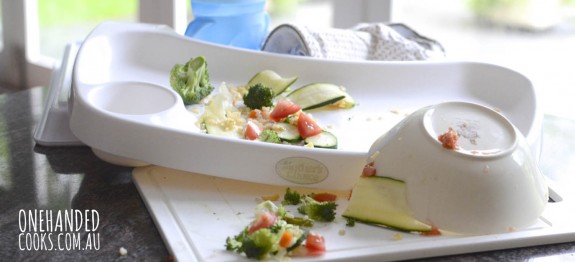Fussy Eating & The Mealtime Ritual
So, you have a fussy eater, which probably means you’re losing your hair or going grey, either way it’s not a nice feeling. It is a good idea to first read our post on Fussy Eating – How it Starts for common reasons fussy eating starts so you can tailor a plan to suit your needs.
We have devised “The Mealtime Ritual” which is a list of basic steps you can follow to get your fusspots back on track. Whatever method you choose, try and stick with consistent tactics to give your child the best chance of changing their habits and learning to love food. You know your child best and what might work for some wont work for others. Pick and choose to personalise a plan for your child, then adjust and modify until you find a solution that works. Oh, and if you do find something that works, please feel free to share the secret.
All children have it in them to be good eaters and to associate foods with positive experiences.
The One Handed Cooks Mealtime Ritual
Set the rules:
- Let your kids know in advance what behavior you expect. For older children devise a set of table rules with them. By setting the rules themselves they acknowledge they are fair and are more inclined to keep to them. As part of the rules, let them know what the consequences will be if they are not abided.
- Let your children know there will be no alternative meals to the one being provided. Rather, there will be options for them to pick and choose from. This way you are giving them choice but inevitably you are the one in control, so each food should be something you are happy for them to eat.
Ambiance:
- Plan enough time for an unhurried meal.
- Set aside a period of time before the meal to have some quiet time. This is a good idea before every meal. Read a story, turn on some relaxing music, and wash their hands. (Harry and I listen to “ABC Classic drive” it is my indulgent nanna moment and he completely relaxes.)
Cooking & Preparation:
- Respect children’s preference for different foods but do not pander so much as organizing a different meal for each child. Slight adaptions are OK, and incorporating each child’s (healthy) favourite meal into the weekly plan helps them feel rewarded.
- Offer new foods with known and accepted foods. Children find it confronting to be offered a whole plate of something new. It’s better to not make a big deal about it, place the new food in amongst the old and have the expectation that they will try it.
- Allow children to participate in food preparation. (I like to give Harry a tour of dinner as I am preparing it, letting him help where he can, or try a bit of sauce here and there so he feels involved.)
- Present food in a way that is easy for children to manage because they become easily distracted and if food is too hard to eat, the will simply not bother.
- Changing the shape, colour, taste, texture of the preferred foods can help with progression to new foods (e.g instead of the usual chicken drumstick, try chicken breast fillet stir-fry etc).
At the table:
- Be sure your children are comfortable seated, and have the right age appropriate equipment for eating. (In this house, Harry has one fork and I have the other, I let him learn how to feed himself, but I help along to way.)
- Give babies and young toddlers a “sign” for when they have had enough and respect that. (Ever since Harry started solids I have said “All done” and waved both my hands in the air. As he can’t yet talk, he does this action when he has had enough. I find this is a nicer way to finish rather than having him start throwing food and pushing the plate over the edge.)
- Help children serve themselves small portions and allow seconds once finished. Many children find large portions too overwhelming, you are better offering a small amount and adding to it.
- Try to acknowledge desirable behavior and ignore bad behavior. As strange as it sounds, you are better to not over praise or reward a child for eating or trying the new food. Remain happy and encouraging but act as though this is the expected behavior and eventually it will be.
- Never offer desserts and fruits a reward for eating the main meal. Make these options nutritious and offer them with the main meal.
- Eat with your children, talk to them, listen to them, and set a good example by eating a wide variety of foods and be happy to try new ones.
- Try going through the new routine with older children every morning before breakfast. You can use our free printable to stick on the fridge as a reminder or create your own specific to your needs. A tick list or star chart often works wonders too.
(Please remember to read our site disclaimer as the information we provide does not constitute medical advice and is not intended to replace the personalised care and advice given to you by your health professional team.)




























